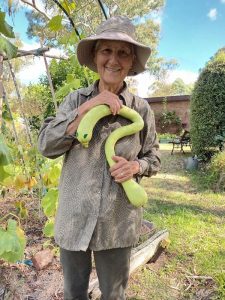Eltham gardener grows freak vegetable. Tales of magic in the garden.
Rita Sidewell-West, Gardening Correspondent of the Eltham Echo, investigates.
 For the second year in a row, Eltham gardener, Ruth Seidler, 72, has grown an unusual Italian heirloom zucchini variety called tromboncino. Its scientific name is Cucurbita moschata ‘Tromboncino’. One of its other names is serpentine squash (snake-like squash). This year something unusual occurred.
For the second year in a row, Eltham gardener, Ruth Seidler, 72, has grown an unusual Italian heirloom zucchini variety called tromboncino. Its scientific name is Cucurbita moschata ‘Tromboncino’. One of its other names is serpentine squash (snake-like squash). This year something unusual occurred.
Ms Seidler trained the vines of her 3 plants to grow up a garden arch. Every day she went out to the veggie patch to check progress, twisting a new shoot or tendril around onto a support, watering and especially to see if there were flowers open. Like all plants in the cucurbit family (pumpkins, cucumbers and squash), tromboncinos have big yellow flowers that the bees love. Each plant grows male and female flowers. The male flowers grow on a straight stem but the female flowers grow at the end of a baby fruit shape instead.
Some days Gardener Ruth found 4 male flowers open, sometimes just one female flower and on good days one or more of each would be open. On these days, excited but calm, she used a feather or cotton bud to carefully collect some pollen from the male flower and wipe it on to the inside parts of the female flowers. “This is normally bees’ business,” she says, but she didn’t want to leave anything to chance. Often she found a bee busy inside a flower and waited until it had left with its load of pollen. Some days were dull and cool and there were not many bees around or they flew off after they had collected pollen. If the female flower received pollen at the right time a pale green tromboncino began to grow. If not, they turned yellow and withered on the vine. The healthy ones grew almost as long as Ruth’s arm, some straight, others curved.
One particular tromboncino grew vigorously, twisting like a snake, finding support on the arch.
“It was somehow different from the others,” Ruth says.
Every day she patted its thickening curves. She even gave it a name, Tromby.
“One day as I touched Tromby, I sensed the slightest stirring or a kind of pulsing. He (or was it she?) seemed to move towards my hand as if it wanted more stroking. I thought I even heard a gentle sighing sound. Next day, two green shapes like eyelids appeared at one end. I couldn’t believe it! What was this? A vegetable with animal qualities? I remembered its other name: serpentine squash. Was this this a freak of nature? I didn’t know what to think or do.”
Tromby was getting big enough to harvest. Would it be cruel to cut Tromby off the vine? She waited one day, then another. Then one morning, Tromby seemed to be leaning more heavily on the support, Ruth heard a long sigh and there was no hint of movement in the long curved body.
“Tromby seemed to be giving me permission to cut him from the vine. I used my sharp knife as gently and quickly as I could. Tromby was surprisingly heavy in my hands. He seemed to snuggle into my body as I carried him inside.”
Tromby lay still and silent on the kitchen table for several days.
Gardener Ruth says later, “At first I kept sharp knives, peelers and graters away. It seemed insensitive to say the words ratatouille, zucchini slice or stuffed vegetables in the same space. However, after about a week I decided this very large vegetable, however mysterious, was getting in the way and it was time to use it in my cooking. Perhaps I’m heartless, but Tromby became just another healthy vegetable. I cut a piece off and put the rest in the fridge. I was still curious though.”
Ms Seidler began to search the internet. Had other gardeners had unusual experiences with their tromboncinos? There were some hints of tales of magical vegetables in an ancient language of Liguria in Italy but nothing else. Fairy tales perhaps.
She eventually contacted this reporter. We met by her veggie patch where one of the intriguing long cucurbits was still hanging among the yellowing leaves of the vine. By this time she had used the “magic” tromboncino in five different meals and there was no physical evidence to examine. As I listened to her story I couldn’t help noticing that we were standing very close to the Diamond Creek. I asked if she ever saw snakes in her garden. “Oh, yes,” was her reply. “In fact, I’m sorry to say, over the years, several tiger snakes have met nasty ends right here, when we have had the veggie patch netted for birds … Aaaah … Ah-ha.” She stopped. A sudden realisation seemed to come to her.
“Perhaps, just perhaps, the spirits of those snakes are still around. Perhaps one found its way into a familiar shape … Just for a short time …” Who will ever know?
I ask if she will grow tromboncino next summer. “I’ll have to think about that,” is her reply. “I might go back to common Blackjack zucchini again.”
What do readers think? Eltham Echo would like to hear other gardeners’ experiences, especially if you have grown unusual varieties.
